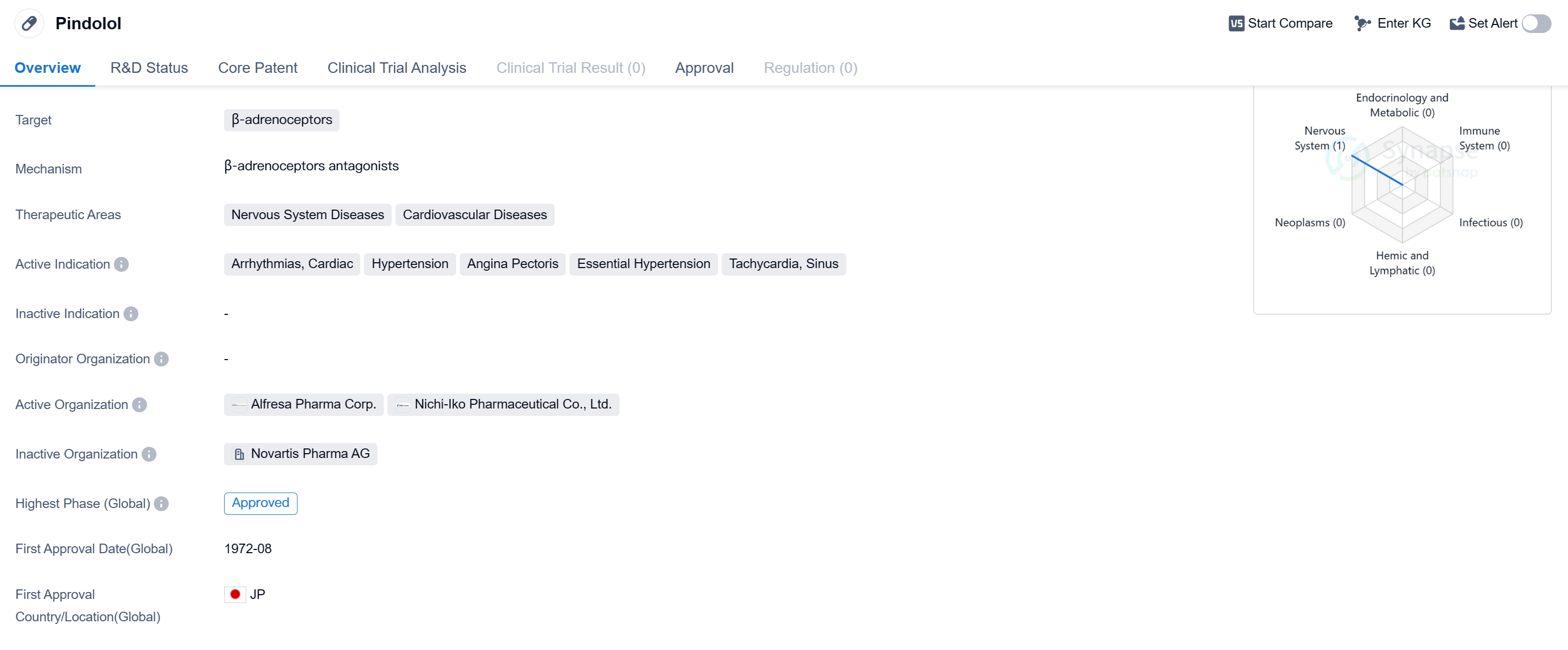Exploring Pindolol's Revolutionary R&D Successes and its Mechanism of Action on Drug Target
Pindolol's R&D Progress
Pindolol is a small molecule drug that belongs to the class of β-adrenoceptor antagonists. It is primarily used in the treatment of various nervous system and cardiovascular diseases. The drug has been approved for use in multiple countries, including Japan, and has been available since August 1972.
Pindolol acts by targeting β-adrenoceptors, which are receptors found in the body that respond to the neurotransmitter adrenaline. By blocking these receptors, Pindolol helps regulate the activity of the sympathetic nervous system, which is responsible for the "fight or flight" response. This mechanism of action makes Pindolol effective in treating conditions such as arrhythmias, cardiac issues, hypertension, angina pectoris, essential hypertension, tachycardia, and sinus problems.
The drug has undergone extensive clinical trials and has reached the highest phase of approval globally and in China. Pindolol's approval in Japan as the first country/location suggests that it has been widely used and accepted in the medical community.
Pindolol's long history of use since its first approval in 1972 demonstrates its established position in the pharmaceutical market. It has been prescribed to patients suffering from various nervous system and cardiovascular diseases for several decades. The drug's small molecule nature allows for easy administration and absorption in the body, making it a convenient option for patients.
👇Please click on the image below to directly access the latest data (R&D Status | Core Patent | Clinical Trial | Approval status in Global countries) of this drug.
Mechanism of Action for Pindolol: β-adrenoceptor antagonists
β-adrenoceptor antagonists, also known as beta-blockers, are a class of drugs that block the action of β-adrenoceptors in the body. β-adrenoceptors are receptors found on the surface of cells in various tissues, including the heart, lungs, blood vessels, and other organs. These receptors are activated by the neurotransmitters epinephrine (adrenaline) and norepinephrine (noradrenaline), which are released by the sympathetic nervous system.
By blocking the β-adrenoceptors, beta-blockers prevent the binding of epinephrine and norepinephrine to these receptors. This leads to a decrease in the effects of sympathetic stimulation, resulting in a reduction in heart rate, blood pressure, and contractility of the heart muscle. Beta-blockers are commonly used to treat conditions such as hypertension (high blood pressure), angina (chest pain), arrhythmias (abnormal heart rhythms), and certain types of heart failure.
From a biomedical perspective, β-adrenoceptor antagonists work by interfering with the β-adrenergic signaling pathway, which plays a crucial role in regulating cardiovascular function. By blocking the effects of sympathetic stimulation, these drugs help to restore the balance of the autonomic nervous system and improve cardiovascular health.
Drug Target R&D Trends for Pindolol
According to Patsnap Synapse, as of 10 Sep 2023, there are a total of 430 β-adrenoceptors drugs worldwide, from 386 organizations, covering 170 indications, and conducting 5165 clinical trials.
The analysis of the current competitive landscape and future development of target β-adrenoceptorsreveals that Novartis AG, AstraZeneca PLC, GSK Plc, and C.H. Boehringer Sohn AG & Co. KG are the companies growing fastest under this target. The highest stage of development is seen in Novartis AG, with a significant number of approved drugs. The indications with the highest number of approved drugs are asthma, hypertension, and pulmonary disease, chronic obstructive. Small molecule drugs are progressing most rapidly under the current target, indicating intense competition. China, Japan, and the United States are the countries/locations developing fastest under the current target, with China showing significant progress in terms of approved drugs. Overall, the target β-adrenoceptors present a competitive landscape with potential for future development in various indications and drug types.
👇Please click on the picture link below for free registration or log in directly if you have a freemium account, you can browse the latest research progress on drugs, indications, organizations, clinical trials, clinical results, and drug patents related to this target
Conclusion
In summary, Pindolol is a small molecule drug that targets β-adrenoceptors and is used in the treatment of nervous system and cardiovascular diseases. It has been approved globally and in China, with its first approval dating back to 1972 in Japan. The drug's efficacy in managing conditions such as arrhythmias, hypertension, and angina pectoris has made it a valuable therapeutic option for patients worldwide.






